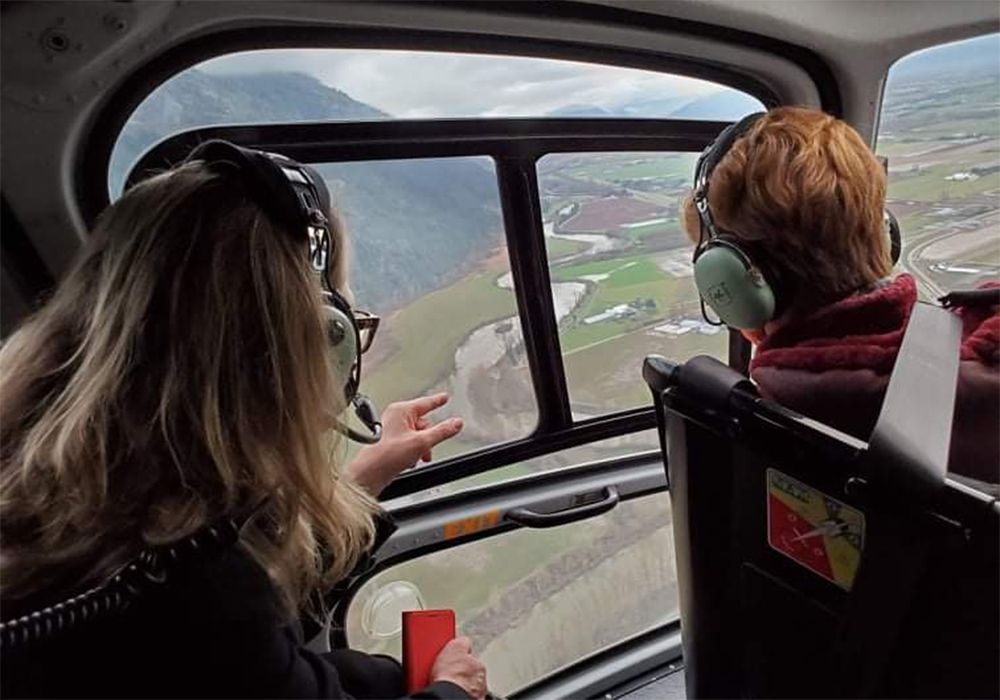Future protection stressed in aftermath of B.C. flooding

Governments must invest in infrastructure to prevent disasters such as the flooding that hit farmers in British Columbia, says an agriculture industry leader.
Increasing weather extremes caused by climate change mean officials must start making wiser decisions, said Stan Vander Waal, chair of the B.C. Agriculture Council.
“Yes, we need the government to put in more money for disaster relief, but I would much prefer that the government takes a preventive approach… so that we don’t have to pay out relief,” he said.
“Obviously, there will always be relief that’s needed for certain catastrophic events you can say that are totally outside our control, but we have to take some accountability about what we can control, and like I say, back to this event, I believe we had the ability to control this.”
Vander Waal said officials have known for years that existing measures such as dikes were insufficient to handle a major rain event such as the atmospheric river that hit Sumas Prairie near Abbotsford, B.C. The area is the site of a former lake that was drained to create farmland in the 1920s.
A report commissioned by the B.C. government not only found in 2015 the Sumas River dike was substandard and needed updating, it also said 74 dikes in the Lower Mainland generally did not meet provincial standards.
Flooding forced B.C. to declare a state of emergency Nov. 17. About 819 farms were under evacuation orders as of Dec. 2 after hundreds of thousands of farm animals perished, affecting much of the province’s agriculture.
Road and rail links were severed, leaving everyone from dairy to poultry farmers scrambling to get feed, water and veterinary care for animals. It also prevented producers from getting their goods to consumers, said Vander Waal.
Although farmers worked with government officials to address gaps in the food supply chain, “I want to say here in B.C., we got unbelievably close to disaster when it came down to our food systems … we certainly wouldn’t want to have many more of these.”
His comments came as B.C. Agriculture Minister Lana Popham and federal Agriculture Minister Marie-Claude Bibeau toured the Abbotsford area Dec. 10.
“Food security in British Columbia and Canada is top of mind for people, and farmers have fed us for years and years,” said Popham during a joint news conference at a farm affected by flooding. “And now it’s the time for us to have their back to make sure that they continue doing that.”
Popham said the issues rebuilding dikes and providing better preventive measures for future storms is a greater conversation that needs to happen.
She added that “today, we’re focused mostly on the immediate needs of farmers and getting them through the next few months.”
The current five-year, $3-billion Canadian Agricultural Partnership expires March 31, 2023. Agricultural ministers hope to sign an agreement for the next five-year policy framework at a meeting in July 2022.
During an interview Dec. 10, Bibeau said an inter-ministerial committee has been formed with B.C. to discuss things such as major infrastructure, although “maybe not under this partnership agreement under agriculture. But this is certainly something that we are looking at in identifying what the priorities are, and under which type of collaboration we can improve them.”
Popham and Bibeau did not mention the federal-provincial AgriRecovery disaster relief program during the news conference. It was first implemented in September after B.C. farmers were hit by record-breaking heat waves and wildfires.
Bibeau said in the interview that both governments were still working together to evaluate the impact of the flooding on farmers.
“I feel it’s going to be done by phase because we can already appreciate some work that has to be done and some exceptional costs that they are facing, but I mean there will still be impacts that are hard to evaluate right now … and I can assure you that our teams, federal and provincial, are working around the clock to figure out a first phase of AgriRecovery.”
As they begin cleanup and recovery from the flooding, many farmers in areas such as Sumas Prairie will need financial help because they were unable to get flood insurance, said Vander Waal. “The big questions are how do you deal in with the farmer that does not qualify for AgriRecovery?”
It excludes smaller producers whose off-farm income is more than 50 percent, he said. The program also excludes farms involving corporations, commonly formed by producers for things such as tax purposes, or that have more than $1 million in revenue, he added.
“Government’s aware of this, and these discussions are being brought up, but you could say from an industry point of view, of course, that leaves an awful lot of people out in the cold.”
He also heard during a call Dec. 9 that payouts are to be set at a maximum of $300,000 per operation. He expected some farmers could face losses of $1 million or more.
However, Bibeau said farmers are the “first ones to face the impact of climate change, and we want to be that best support in terms of adaptation, being more resilient and also having the right programs in place for (an) emergency.”
Contact doug.ferguson@producer.com
Source: producer.com

